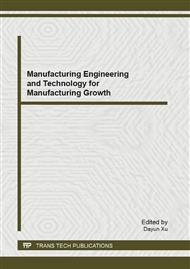[1]
T. Childs, K. Maekawa, T. Obikawa, Y. Yamane, Metal Machining: Theory and Applications; Arnold Publishers, London, (2000).
Google Scholar
[2]
E.M. Trent, P.K. Wright, Metal Cutting, 4th Ed.; Butterworth-Heinemann, Woburn MA, (2000).
Google Scholar
[3]
A. Iqbal, N. He, N.U. Dar, L. Li, Comparison of Fuzzy Expert System Based Strategies of Offline and Online Estimation of Flank Wear in Hard Milling Process, Expert Systems with Applications, Vol. 33, No. 1, 2007, pp.61-66.
DOI: 10.1016/j.eswa.2006.04.003
Google Scholar
[4]
S.V. Wong, A.M.S. Hamouda, M.A. El-Baradie, Generalized Fuzzy Model for Metal Cutting Data Selection. Journal of Material Processing Technology, Vol. 89–90, 1999, p.310–317.
DOI: 10.1016/s0924-0136(99)00127-2
Google Scholar
[5]
Y. Chen, A. Hui, R. Du, A Fuzzy Expert System for the Design of Machining Operations. International Journal of Machine Tools & Manufacture, Vol. 35, No. 12, 1995, pp.1605-1621.
DOI: 10.1016/0890-6955(95)00024-r
Google Scholar
[6]
K. Hashmi, I.D. Graham, B. Mills, Data Selection for Turning Carbon Steel Using a Fuzzy Logic Approach. Journal of Materials Processing Technology, Vol. 135, 2003, p.44–58.
DOI: 10.1016/s0924-0136(02)01011-7
Google Scholar
[7]
K. Hashmi, M.A. El Baradie, M. Ryan, Fuzzy Logic Based Intelligent Selection of Machining Parameters. Computers in Industrial Engineering, Vol. 35, No. 3–4, 1998, p.571–574.
DOI: 10.1016/s0360-8352(98)00161-2
Google Scholar
[8]
S.V. Wong, A.M.S. Hamouda, A Fuzzy Logic Based Expert System for Machinability Data-On-Demand on the Internet. Journal of Materials Processing Technology, Vol. 124, 2002, p.57–66.
DOI: 10.1016/s0924-0136(02)00091-2
Google Scholar
[9]
S.V. Wong, A.M.S. Hamouda, The Development of an Online Knowledge-Based Expert System for Machinability Data Selection. Knowledge-Based Systems, Vol. 16, 2003, p.215–229.
DOI: 10.1016/s0950-7051(02)00083-7
Google Scholar
[10]
A. Kohli, U.S. Dixit, A Neural-Network-Based Methodology for the Prediction of Surface Roughness in a Turning Process, The International Journal of Advanced Manufacturing Technology, Vol. 25, No. 1-2, 2005, pp.118-129.
DOI: 10.1007/s00170-003-1810-z
Google Scholar
[11]
H. Oktem, T. Erzurumlu, F. Erzincanli, Prediction of Minimum Surface Roughness in End Milling Mold Parts Using Neural Network and Genetic Algorithm, Materials and Design, Vol. 27, 2006, p.735–744.
DOI: 10.1016/j.matdes.2005.01.010
Google Scholar
[12]
T. Ozel, Y. Karpat, Predictive Modeling of Surface Roughness and Tool Wear in Hard Turning Using Regression and Neural Networks, International Journal of Machine Tools & Manufacture, Vol. 45, 2005, p.467–479.
DOI: 10.1016/j.ijmachtools.2004.09.007
Google Scholar
[13]
A. Iqbal, N. He, L. Li, Y. Xia, Influence of Cutter's Helix Angle, Workpiece Hardness, Milling Orientation, and MQL in High-Speed Side Milling of AISI D2, Advances in Materials Manufacturing Science and Technology II, Vols. 532-533, 2006, pp.45-48.
DOI: 10.4028/www.scientific.net/msf.532-533.45
Google Scholar
[14]
A. Iqbal, I. Khan, N.U. Dar, N. He, L. Li, Modeling the Effects of Cutting Parameters in MQL-Employed Finish Hard Milling Process Using D-Optimal Method, Journal of Materials Processing Technology, Vol. 199, No. 1 – 3, 2008, pp.379-390.
DOI: 10.1016/j.jmatprotec.2007.08.029
Google Scholar
[15]
A. Iqbal, I. Khan, N.U. Dar, Optimizing Cutting Parameters in Minimum Quantity of Lubrication Milling of Hardened Cold Work Tool Steel, Journal of Engineering Manufacture (Proc. I Mech. Eng. Part B); Vol. 223(B1), 2008, pp.43-54.
DOI: 10.1243/09544054jem1231
Google Scholar


